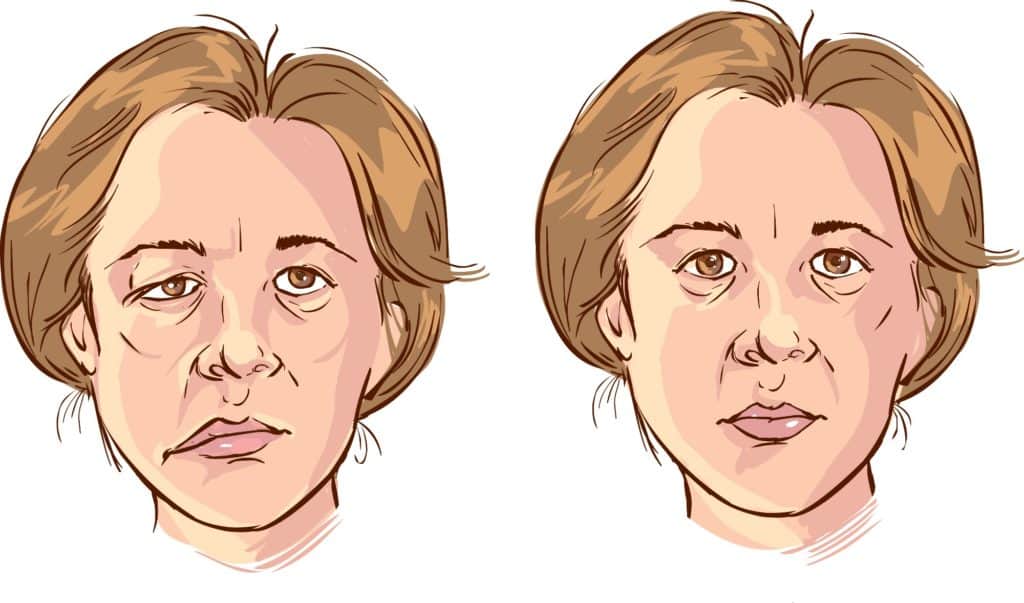
The patient was 34-years-old and well into her third pregnancy. She came to the ER concerned that she was having a stroke. Her pregnancy and general health had been unremarkable until she awoke this morning. Something didn’t seem right about the right side of her face. Looking in the mirror, she realized she had a lopsided smile. The right side of her face didn’t seem to be working.
Upon further questioning, she admitted to having some discomfort in her right ear area for the last few days, along with more sensitivity to certain sounds in the environment. She denied any rashes, fevers, tick bites, headaches or trauma.
Understandably, in a panic she had rushed to the ED. Her vital signs were normal except on initial presentation, a slightly elevated heart rate was present consistent with anxiety and advanced term of pregnancy. Otherwise her pulse rhythm and quality were normal. She had an obvious weakness of her right face; unable to raise the right side of her mouth or completely close the right eye. Importantly, she also had a decreased ability to raise the right eyebrow. She had no other neurologic abnormalities. There were also no signs of a rash in or around the ear.
Bell’s Palsy is a unilateral facial paralysis due to inflammation of the 7th cranial nerve on the affected side. Incidence is about 30/100,000. For some reason, it seems to be more common in pregnancy but can occur in either gender at any time. It may be associated with herpes simplex or herpes zoster infection, but often the cause is not found.
It typically comes on over a few hours to days, and may continue to worsen for up to 3 weeks before beginning a slow course of resolution. The paralysis is often preceded by a few days of ear pain or altered sensation to sound.
It can be easily confused with an acute stroke by the general public. The onset is not as rapid as a stroke, but of course if one wakes up with it, then whether symptoms came on over a few hours or instantly can not be known. The key difference between Bell’s Palsy and stroke is the unilateral paralysis of the face most often includes the forehead in the case of Bell’s Palsy.
In the case of a stroke, the forehead is spared due to bilateral origin of innervation. Also, other than the unilateral facial paralysis, decreased tearing and possible loss of taste on the affected side of the tongue, there are no other neurologic abnormalities.
With some reassurance and explanation, I was able to calm the patient. The prognosis was good as she presented early and had only moderate weakness. With treatment she would most likely see some improvement in a few weeks. I prescribed Prednisone and an antiviral medication. Also she was directed to use an ophthalmic lubricant regularly in her right eye to protect the cornea from drying out. She was directed to be rechecked by her primary MD in 3 weeks as patients that continue to worsen will need further evaluation with imaging or possibly serologic testing for lymes disease.
Upon further questioning, she admitted to having some discomfort in her right ear area for the last few days, along with more sensitivity to certain sounds in the environment. She denied any rashes, fevers, tick bites, headaches or trauma.
Understandably, in a panic she had rushed to the ED. Her vital signs were normal except on initial presentation, a slightly elevated heart rate was present consistent with anxiety and advanced term of pregnancy. Otherwise her pulse rhythm and quality were normal. She had an obvious weakness of her right face; unable to raise the right side of her mouth or completely close the right eye. Importantly, she also had a decreased ability to raise the right eyebrow. She had no other neurologic abnormalities. There were also no signs of a rash in or around the ear.
Bell’s Palsy is a unilateral facial paralysis due to inflammation of the 7th cranial nerve on the affected side. Incidence is about 30/100,000. For some reason, it seems to be more common in pregnancy but can occur in either gender at any time. It may be associated with herpes simplex or herpes zoster infection, but often the cause is not found.
It typically comes on over a few hours to days, and may continue to worsen for up to 3 weeks before beginning a slow course of resolution. The paralysis is often preceded by a few days of ear pain or altered sensation to sound.
It can be easily confused with an acute stroke by the general public. The onset is not as rapid as a stroke, but of course if one wakes up with it, then whether symptoms came on over a few hours or instantly can not be known. The key difference between Bell’s Palsy and stroke is the unilateral paralysis of the face most often includes the forehead in the case of Bell’s Palsy.
In the case of a stroke, the forehead is spared due to bilateral origin of innervation. Also, other than the unilateral facial paralysis, decreased tearing and possible loss of taste on the affected side of the tongue, there are no other neurologic abnormalities.
With some reassurance and explanation, I was able to calm the patient. The prognosis was good as she presented early and had only moderate weakness. With treatment she would most likely see some improvement in a few weeks. I prescribed Prednisone and an antiviral medication. Also she was directed to use an ophthalmic lubricant regularly in her right eye to protect the cornea from drying out. She was directed to be rechecked by her primary MD in 3 weeks as patients that continue to worsen will need further evaluation with imaging or possibly serologic testing for lymes disease.

